6
Teaching Aids in Science
CHAPTER OUTLINE
LEARNING OBJECTIVES
After reading this chapter, you will be able to:
Understand the importance of teaching aids in science
Classify the various types of teaching aids
Comprehend Dale's Cone of Experience
Give examples in different bands of Cone of Experience
Effectively choose and use appropriate teaching aid for a particular class
INTRODUCTION
Children learn science in a variety of ways. They learn it more readily when they are interested in it, when it is graphic, when it involves some manipulation on their part, when it is not too hard and when it gives them the satisfaction of having found out something they wanted to know. Thus, those experiences where special effort is not made to memorize something but learning becomes comparatively permanent due to the involvement of senses help in developing concepts. The use of teaching aids is based only on this idea that a fact or process is more readily learnt if it is presented through the medium of more than one sense.
NEED AND IMPORTANCE OF TEACHING AIDS
In our schools, mostly no teaching aids are used to teach science.Very rarely, some motivated teachers make personal efforts and show some specimens to students. Usually, children just memorize things without any understanding. Teaching aids if properly used help in teaching learning process in many ways and can ensure quick and effective learning as given below:
- Teaching aids help a learner to achieve learning objectives more effectively.
- Teaching aids create readiness for learning experience in a learner
- Information is clear, precise and accurate when learnt by using teaching aids.
- Teaching aids create visual images which help in long term retention of concepts.
- Depending upon the type of aid used, teaching aids may provide stimulation to senses, real experience and opportunity to the learner to learn at his/her own pace. (Fig. 6.1)
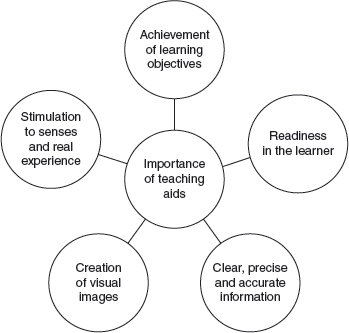
Figure 6.1 Importance of Teaching Aids
TYPES OF TEACHING AIDS
Teaching aids can be classified in many ways on the basis of their characteristics. Four types of classification are being discussed here:
I. On the Basis of the Sense Organs Involved
Traditionally used teaching aids stimulated only one sense organ i.e. ears or eyes. More contemporary teaching aids provide stimulation to ears and eyes together and in many emerging aids, other sense organs are also involved. Pictorial depiction of this classification is given in Figure 6.2
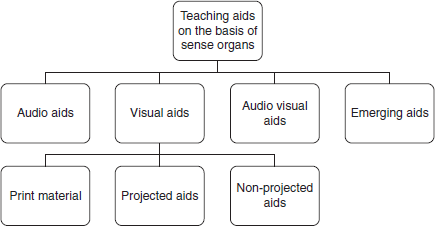
Figure 6.2 Teaching Aids on the Basis of Sense Organs
II. On the Basis of the Size of Learner Groups
Teaching aids can be classified on the basis of the number of students in the class. A learner can be an individual, a small group or large groups of individuals. (Fig. 6.3)
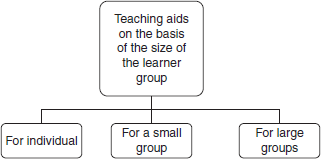
Figure 6.3 Teaching Aids on the Basis of the Size of the Learner Group
III. On the Basis of Learners’ Control over Teaching Aids
Some teaching aids are completely in the hands of learners whereas some other depend on many external variables e.g. electricity, infrastructure, etc. Some teaching aids can be controlled by the learner to some extent only. (Figure 6.4).
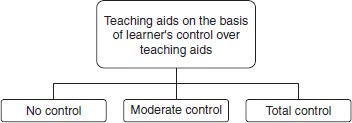
Figure 6.4 Teaching Aids on the Basis of Learner's Control over Teaching Aids
IV. On the Basis of the Experience Provided by an Aid
Some teaching aids are more concrete in nature while some are more abstract. The type of experience provided by various teaching aids has been arranged in a pictorial form in the Cone of Experience given by Prof. Edgar Dale. (Figure 6.5)
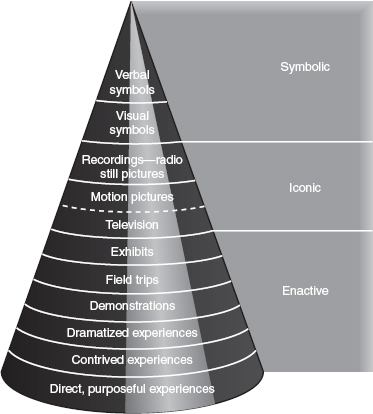
Figure 6.5 Dale's Cone of Experience for Teaching Aids
DALE'S CONE OF EXPERIENCE
At the top of the cone are verbal symbols which are the most abstract while at the base are direct purposeful experiences which are the most concrete form of experience. Various bands of this cone represent various aids and experience. As we move from top to bottom, teaching aids become more concrete. These aids are not arranged on the basis of their effectiveness but on the basis of their concreteness or abstractness. Many teaching aids overlap in various bands. It is up to the teacher to use an aid in the best possible manner. All the bands and teaching aids are being discussed here one by one.
1. Direct Purposeful Experiences
Direct experiences are very useful for effective comprehension but they need to be purposeful. All such experiences may not be meaningful especially when the real things are too small or too big to comprehend e.g. airport, factory, atom, furnace, ecosystem, etc. The science teacher has to decide the type of direct experiences which will be useful for their students. Some examples are – phyllotaxy, types of leaves, structure of flower, common animals. (Figure 6.6)
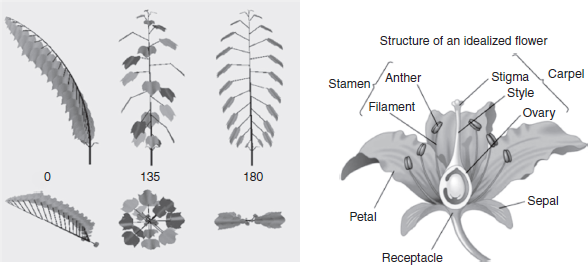
Figure 6.6 Specimens for direct experience
2. Contrived Experiences
Whenever direct experience is not possible or is not useful, contrived experiences are used. Contrived experiences include models, specimens, dioramas (Scenic painting with special lighting effects). These are usually simplified and edited version of the real thing. Unnecessary details may be removed according to the age of the students e.g. an ecosystem is difficult to comprehend in real situation; therefore, a model is more meaningful. Half cut models of internal structures of root eye, ear etc. are very useful. Sometimes contrived experiences in the form of imaginary models help in the formation and development of concept e.g. DNA structure, food chain, atom electron transport, organic compounds. (Figure 6.7)

Figure 6.7 Contrived Experiences
3. Dramatics
From the name, it seems that dramatics is only for languages. But in science also, it has wide scope. It is best suited for primary classes. Science teacher can think of many topics which can be taught through role play or drama. This aid is very useful to teach very abstract and uninteresting ideas. Some topics which can be taught through dramatics are solar system, ecosystem, nutrients, vitamins.
4. Demonstrations
Demonstrations are based on the power of observation only i.e. no action on the part of student is possible. If a teacher wants to show some activity or process to the class, he/she uses demonstration as an aid (Figure 6.8). A teacher needs to plan and try the demonstration before doing it in the class. Merits, demerits and how to improve demonstration has been dealt in detail in the chapter “Methods of Teaching Science”.

Figure 6.8 Demonstrations in the Class
5. Field Trips or Excursions
Arranging field trips or excursions to solve problems and to give information and appreciations are important activities in science. Trips to a park, zoo, telephone exchange, sea beach or crop fields can be arranged by teachers. These can, however, result in a pain for teachers, a mere holiday for students, and bad publicity for a school, unless they are well-planned and motivated.
Excursions should be made with a definite purpose in mind to answer questions that are best settled by first hand observations. Students should be aware of the purpose of the trip. The teacher should have knowledge on the place being visited and should ensure that there is plenty of opportunity to see and to ask questions.
Excursion should be an integral part of the subject being studied and not just something to do. Further, it is not necessary that a field trip has to be out of school or of long duration. It can always be planned within school premises – in a field, to school museums, to science laboratories, etc. Field trips can be of immense value to the study of science. Probably, more time should be spent getting ready for an excursion and gathering deductions from it, than on the actual excursion.
6. Exhibits
Exhibits can also be called graphics. They include display of something —models, working models, photographs, charts, diagrams, pictures, etc. Exhibits are essentially to be seen as a spectator. The student is not involved in the making or arranging of exhibits. Exhibits generally overlap with many other bands of the cone of experience. For example, pictures and photographs will come under th e band of still picture also (Fig. 6.9).
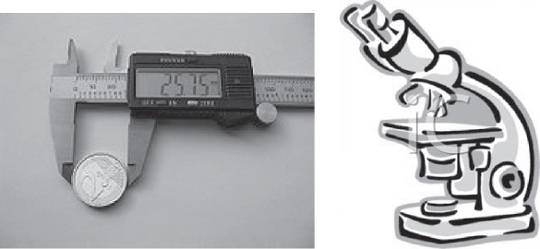
Figure 6.9 Exhibits
Science fairs and museums are such places where all types of exhibits can be seen together. Science fairs are generally organized in a school or they may be an interschool activity. Museum is of two types – public museums and school museums. Public museums may be only science based but mostly they are natural history, art, science & history based. A visit to a public museum needs to be planned and arranged in advance according to the museum schedule. On the other hand, school museums can be visited any time. Generally in schools, biology museums are the most common. A science teacher or whoever is in charge of the museum should ensure that it is not just a collection of various items and objects, but it is also an idea and a process where, to a certain extent, students are also involved.
7. Motion Pictures and Television
Motion pictures: Motion pictures can portray moving phenomena with precision and clarity. They can show in detail those experiments which cannot be demonstrated in a class. Motion pictures can show assembled and correlated illustrations which are otherwise widely separated in time and space. Modern technology enables many changes and modifications in films for effective learning. Some of the technology enabled features being used in films are shown in Figure 6.10.
| Feature | Modification | Example |
| Editing |
• Manipulation of time, space • Elimination of distraction • Relationship of events and things |
Origin of earth Evolution Food web |
| Slow Motion Photography | Control over time |
• Movements in animals, birds etc. • Science and processes eg.-
|
| Time lapse photography | Reduction in large gaps of time |
Blooming Germination Decomposition |
| Microscopic Photography | Enlargement of the actual size of the object |
Microscopic organisms Cell division |
| X-Ray Photography | Enables features not visible by naked eyes |
Internal organs Internal body processes |
| Recording | Replay of events with addition or subtractions |
Prey Hunting by wild animals Eclipses |
Figure 6.10 Features of Motion Films
Science teachers should see and study the film before using it in the class. The following types of films can be used in science teaching:
- Films as illustration: A short film can be introduced into the lesson to illustrate a particular point e.g. during the teaching of the digestive system, actions of enzymes in various organs can be shown using a film. Similarly, while teaching petroleum, each side product, its extraction & uses can be illustrated through a film. These films enable cyclic actions to be seen over and over again and thus memorized.
- Film lessons: These films may be used as the basis of a lesson. For this, the teacher should have the detailed knowledge of the film content and its usage. The teacher should discuss the film content and the details to be noted by the students. First viewing of the film should be after this brief. Oral and written questions should follow the film screening. Lesson can be concluded with a second screening of the film. Thus, the lesson film should be designed to present a single topic in detail.
- Background films: Generally, documentary and interest films provide a background to science lessons. Science teaching can be improved using well-balanced documentary films on industrial and social themes e.g. pollution, population, hunting or natural disasters.
Educational Television: In most states, school television relays programmes based on the syllabus. A telecast schedule is provided to schools. State Institutes of Educational Technology and Central Institute of Educational Technology, New Delhi produce educational T.V. programmes which are not syllabus based. Rather, they are on general topics of interest to enable enjoyable learning. Besides these two programmes, UGC's countrywide classroom is another educational telecast. Although these programmes are for college students, secondary level students and teachers can also benefit from them. National Network relays some educational programmes such as Quest, Turning Point, etc. Discovery channel, Nat Geo, Animal Planet telecast exclusively educational programmes.
Students should be exposed to such educational programmes and motivated to watch them.
8. Radio Recordings and Still Pictures
Radio programmes: Radio programmes for schools are broadcast by All India Radio in many states. A copy of the schedule is sent to schools so that the school time-table can be planned accordingly. Radio programmes can be used either at the time of broadcast or they can be recorded and used later.
In this category, audio cassettes can also be included. Audio programmes are produced by Central Institute of Educational Technology, State Institute of Educational Technology and Educational Technology Cells of SCERT. Audio programmes should be prepared on those topics which can be understood verbally.
Still pictures: Still pictures overlap with exhibits to some extent. Still pictures include illustrations, slides, film strips, photographs, etc. Some of these can be used with projectors and some without projectors. On this basis, still pictures can be divided into two types non-projected and projected. (Figure 6.11)
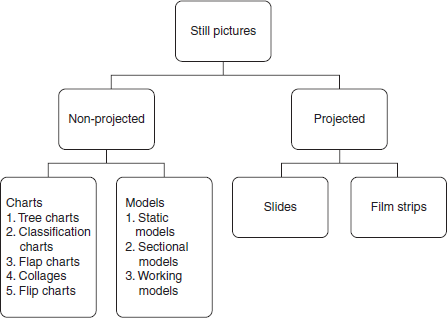
Figure 6.11 Still Pictures
- Non-projected pictures: These are those pictures which do not need any infrastructural facility like electricity or projector. They can be displayed on any board available. Generally, flannel boards or bulletin boards are used for such purpose. Various types of non-projected pictures which can be used for teaching of science are given in Fig. 6.11.
- Charts: A chart is simple, flat, mostly pictorial display and material. If made properly, it can be used very effectively for teaching. Charts are very simple to prepare but they also need careful planning—which caption to be given, which drawing to be made, which colours to be used, how many images to be drawn, how many words to be written, etc. should be decided before hand. On the basis of presentation, charts can be of the following kinds. (Figure 6.12).
- Tree charts: To show various kinds or relationships.
- Classification charts: To present classifications e.g. plant kingdom or animal kingdom.
- Flap charts: Have flaps as in a brochure. These flaps have messages which can be shown whenever required.
- Collages: Are those charts where information or pictures from other sources (newspaper, magazine, etc) are pasted.
- Flip charts: Are a series of charts which are shown one after the other. They are bound to make a flip book or put on a stand and flipped backward like calendar sheets.
- Models: Models are three dimensional aids. They represent real things but size and shape may change. Models may be static, sectional or working. In a static model, parts of a system cannot be separated whereas in a sectional model, it can be done. e.g. if the structure of eye is depicted on thermocol, it is a static model; if cutaway half model of eye is made where all parts can be removed and replaced, it is a sectional model. Working models show actual operation of an object or process, e.g, conduction of electricity, body systems, etc.
- Charts: A chart is simple, flat, mostly pictorial display and material. If made properly, it can be used very effectively for teaching. Charts are very simple to prepare but they also need careful planning—which caption to be given, which drawing to be made, which colours to be used, how many images to be drawn, how many words to be written, etc. should be decided before hand. On the basis of presentation, charts can be of the following kinds. (Figure 6.12).
- Projected Pictures: These pictures need electricity and projectors for their display. Some projected pictures are being discussed here:
- Slides: Slides can be made by a teacher or they can be procured. Self made slides can be prepared by drawing or writing on a transparent film which can be cut into pieces of required size. (Size which can be mounted on a projector).
- Film strips: Film strips have drawings or writings in a sequence. They differ from slides only in this respect that the sequence of pictures cannot be changed in a film strip whereas it can be changed in slides.
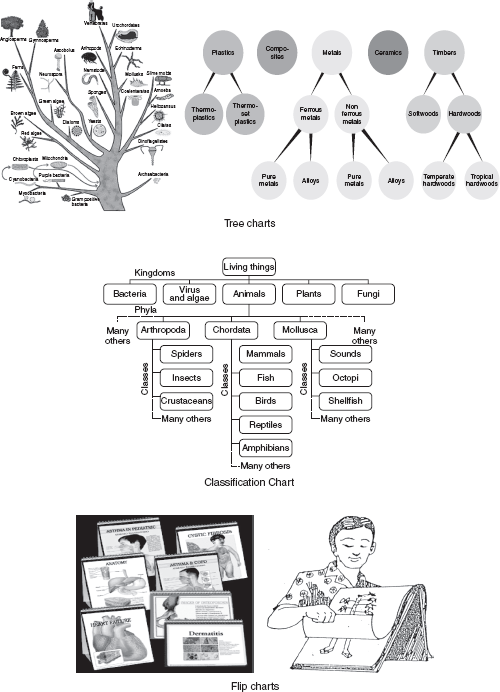
Figure 6.12 Various types of Charts
Projected pictures need projectors for their display. Some common projectors used are (Figure 6.13)
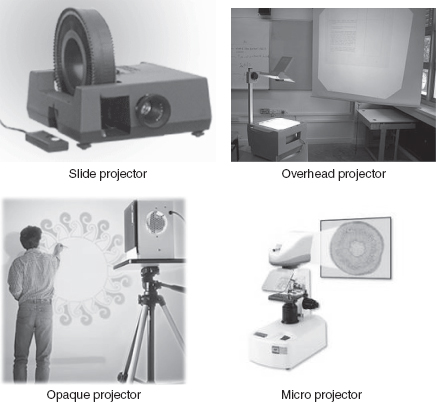
Figure 6.13 Types of Projectors
- Slide projector: Slide projectors are of two types—manual or automatic. For slide show, a dark room is needed, and since it is visual only, commentary is also required.
- Overhead projector: It is the most convenient and effective medium. Here, drawings on transparent sheets are enlarged and projected through lens on to a white screen.
- Opaque projector: This projector is used to enlarge and show some illustration directly from a book, magazine, etc. Any written or printed material can be projected. Opaque thin objects like leaves, moths, fabrics, etc. can also be projected.
- Micro projector: It enlarges images of stained sections of microscopic slides or other mounted images. Many times, students don't understand diagrams or slides through a microscope as they view them without any explanation. In such cases, a micro projector can be used to illustrate the images to large groups of students together.
9. Visual Symbols
These include representations of real pictures, e.g, drawings, sketches, graphs, maps, etc. Diagrams made by teachers also come under this and they are in complete control of teachers. A teacher uses blackboard or chalkboard for this purpose. (Figure 6.14).
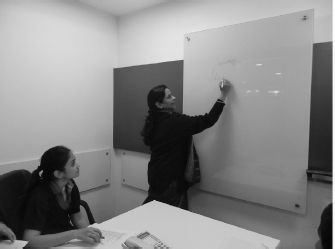
Figure 6.14 Teacher Using a Board
10. Verbal Symbols
This is the most abstract form of learning experience. All printed materials are included in verbal symbols, e.g, books, newspapers, magazines, etc. (Fig. 6.15). Books are the most commonly used verbal experience; therefore, books should be written in comprehensible language with appropriate illustrations. References should be included from real life surroundings.
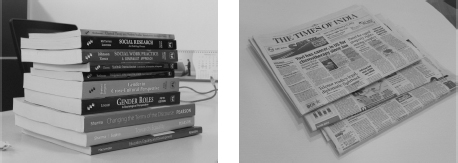
Figure 6.15 Verbal Symbols
In view of the discussion above, Dale's Cone can be analysed as in Fig 6.16.
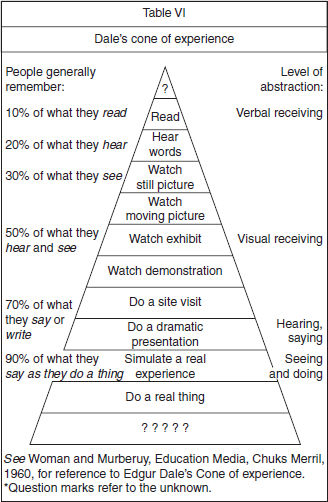
Figure 6.16 Dale's Cone of Experience (Just highlighting the fact that Dale's cone has been used the second time in this chapter.)
EFFECTIVE USE OF TEACHING AIDS
Many teaching aids are available for a science teacher and he/she has to decide about which aid will be most suitable for a particular topic to be taught to a class. Here are some points which should be kept in mind by a science teacher before selecting an aid:
- A teaching aid is not a substitute for teaching.
- An aid should not be very costly.
- Teaching aids should supplement classroom teaching.
- It should be simple and easily understandable.
- Teachers should be able to use the aid effectively.
- It should create interest among students.
- It should not be very time-consuming.
- Teaching aid should fulfill the teaching objectives for a particular topic.
SUMMARY
- Teaching aids, if properly used, help in teaching and learning process and ensure quick and effective learning.
- Teaching aids can be classified in four ways on the basis of:
- Prof. Edgar Dale has given Cone of Experience which describes various types or aids in a systematic manner.
- Cone of Experience has 10 bands which are:
- Direct purposeful experiences
- Contrived experiences
- Dramatics
- Demonstrations
- Field trips or excursions
- Exhibits
- Motion pictures and television
- Radio Recordings and Still Pictures
- Visual symbols
- Verbal symbols
- Films as teaching aids can be used as illustration—as a lesson or as a background film.
- Still pictures can be non-projected or projected.
- Non-projected pictures include charts and models. Charts are of the following types: tree charts. Classification charts, flap charts, collages and flip charts. Models are of three types—Sectional models, static models and working models.
- Projected pictures include slides and film strips. These can be projected using a slide projector, opaque projector, overhead projector or micro projector depending on the illustration.
- Teaching aids should be selected carefully otherwise the objectives will not be fulfilled.
QUESTIONS
- Justify the use of teaching aids in science teaching.
- What is the use of teaching aids in science?
- Describe various kinds of teaching aids which can be used in the teaching of science.
- What is the importance of motion films in science teaching?
- Name different types of projectors and their uses.
- How will you use the following in making your teaching effective:
- Contrived experience
- Dramatics
- Radio broadcast
- Field trips
- What precautions should be taken before selecting a teaching aid?
